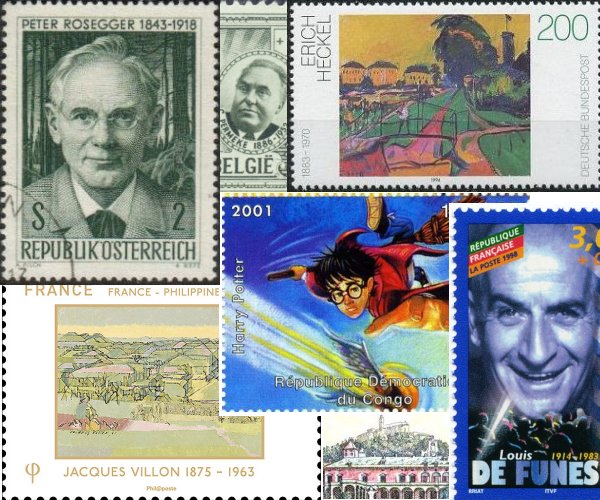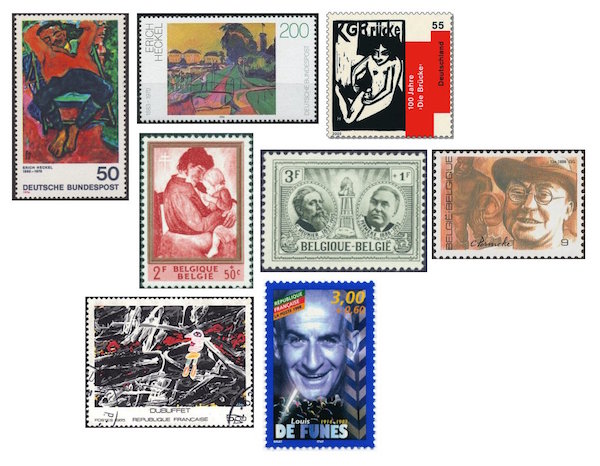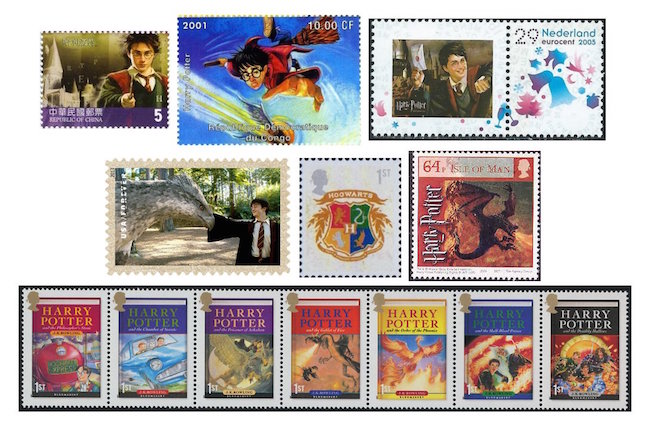The Arts on Stamps of the World — July 31
An Arts Fuse regular feature: the arts on stamps of the world.

By Doug Briscoe
We have no Greats (with a capital G) for July 31, but highly talented people of considerable interest? You betcha.
For the Italian sculptor Alessandro Algardi (31 July 1598 – 10 June 1654) we have only a single stamp, and that is not the best representation of his work. Algardi was not an architect, although he was in charge of the creation of the Villa Doria Pamphili seen on the Italian stamp of 1984. He probably had assistance from Girolamo Rainaldi and Giovanni Francesco Grimaldi on that project. As for Algardi’s own corpus, he made the funeral monument for Pope Leo XI in 1634 and was a protégé of his successor, Innocent X. He became successful with his sculptural portraiture and met Velázquez, who got him commissions from Spain. Algardi’s final masterpiece was a large high-relief panel of Pope Leo I and Attila (1646–53) for St Peter’s.
Composer François-Auguste Gevaert (1828 – 24 December 1908) won the Belgian Prix de Rome in 1847. He headed the Brussels Conservatory from 1871 to 1908 and is nowadays remembered more as a teacher than as a composer. One of his students was Alfred Wotquenne, who created the “Wq.” catalogue of C.P.E. Bach’s works. Gevaert’s music consists mostly in large scale vocal works including a dozen operas, a Requiem, a Te Deum, and a number of secular cantatas.
Austrian poet Peter Rosegger (original Roßegger, 31 July 1843 – 26 June 1918) was born in a mountain village in Styria and had a very limited education. Of a delicate constitution, he couldn’t succeed his father in farming and trained as a tailor instead. In this capacity, Rosegger came into contact with educated people, bought books with his limited income, and yearned to become a writer himself. He had the good fortune to be discovered by two men—a newspaper editor and an industrialist—who encouraged his talent and paid for his schooling. His first book, a story collection called Tales from Styria (Geschichten aus der Steiermark), was published in 1871. Over the succeeding course of his career he was decorated by Emperors Wilhelm II and Franz Josef I and was thrice in the running for a Nobel Prize, nearly winning in 1913. His work is much loved by Austrians, especially the people of Styria. The red and green German pair of stamps, the green one showing his birthplace, was issued during the Third Reich and the later two by Austria.

Ignacio Cervantes Kawanagh (1847 – 29 April 1905) was born and died in Havana. He was a child prodigy. Among his teachers were Louis Moreau Gottschalk, who was visiting Cuba at the time, and Charles-Valentin Alkan at the Paris Conservatory. He is known to have performed with Adelina Patti. He returned to Cuba but fled the country in 1875 on being warned that the government had discovered his political activities. He and violinist José White had with their concerts been raising money to support the rebel cause in what came to be known as the Ten Years’ War (1868–1878) for independence from Spain. At the end of that conflict, he returned again but again departed in 1895 at the start of the Cuban War of Independence, in which the US became involved ( = the Spanish–American War). Cervantes wrote an opera (Maledetto, 1895), zarzuelas, chamber works, and—probably his best known music—the Danzas Cubanas for piano. He was the father of pianist, composer and singer María Cervantes (1885–1981).
The French Cubist and abstract painter Jacques Villon (July 31, 1875 – June 9, 1963) was born Émile Gaston Duchamp and was the elder brother of the artist Marcel Duchamp, whom we presented here just three days ago. He chose the pen name out of admiration for the medieval poet François Villon. Jacques contributed cartoons and illustrations to Paris periodicals and made posters before turning to canvas and prints. To mark the 70th anniversary of diplomatic relations between France and the Philippines, the countries issued a pair of stamps, one showing Villon’s Paysage du Tarn-et-Garonne (1941) and the other a painting by Philippine artist Macario Vitalis (1898-1990), who lived and worked in France for sixty years. I include that stamp today, too, as I have no information regarding Vitalis’s exact birth date.
Like Villon, Erich Heckel (31 July 1883 – 27 January 1970) was both a painter and a printmaker. He studied architecture in Dresden and was one of the founders of the group Die Brücke (“The Bridge”) in 1905. He served as an ambulance driver in World War I but was condemned by the Nazis, who confiscated all his works they could get their hands on. Almost all of his pre-war prints and woodcuts were destroyed. Heckel’s work can be observed on three German stamps from the years 1974, 1994, and 2007: Pechstein Asleep, Landscape, and Franzi Sitting.

As Villon and Heckel were active both as painters and printmakers, so our next two artists were painter/sculptors. Constant Permeke (31 July 1886 – 4 January 1952) was born into what I would have to call a promising environment, given that his father founded the Municipal Museum of Arts in Ostend in 1893. Wounded in World War I, Permeke was evacuated to England for a happy respite. He remained exclusively a painter until 1937, when he turned his hand to sculpture as well. The Nazi occupiers of Belgium prohibited him from practicing his craft, and his son was sent as a forced laborer to Germany. His final years were plagued by the death of his wife and ill health, but brightened by an important retrospective of his work held in Paris in 1947-48. Permeke is remembered on three Belgian stamps: the first reproduces his Maternity (Woman from Ostend, 1913); on the second he shares the honors with his much earlier compatriot Constantin Meunier; and the third has his portrait along with another work I wasn’t able to identify.
French artist Jean Dubuffet (31 July 1901 – 12 May 1985) founded the movement Art Brut, renamed “Outsider Art” in English. Art Brut was an outgrowth of earlier explorations, such as those undertaken by Der blaue Reiter, into the art of prehistory, children, prisoners, and the mentally ill, and Dubuffet amassed a huge collection of such pieces. He had already been painting, off and on, for some thirty years before these influences began to be felt in his own work. He turned to sculpture only in the 1960s and used, as he did in much of his painting, unorthodox materials. What we see on the French stamp of 1985 is an untitled abstract.
French comic actor Louis de Funès (31 July 1914 – 27 January 1983) was a huge favorite not only in France, but throughout much of Europe and beyond. His parents were of the Spanish nobility. Fluent in French, Spanish, and English, he played jazz piano in his youth and always got a laugh with his peculiar facial expressions. These would become a feature of his energetic stage and film work. He played in some eighty films before being given a lead role. In 1963 he became a star with his performance in Jean Girault’s Pouic-Pouic. The two men collaborated on a dozen more films. De Funès had his biggest hit, though, with La Grande Vadrouille (1966), in which he appeared with another great comic actor, Bourvil, whose birthday we just celebrated on the 27th with a stamp from the same set. De Funès worked with many other greats of French cinema.

As you must know, J. K. Rowling’s Harry Potter series has been a blazing success worldwide, as evinced on stamps from Congo, the Netherlands, Taiwan, and even the United States, besides the ones you might expect to see from Great Britain (and the Isle of Man!). The British ones, avoiding the movie associations, come in two sets, one showing the book covers and one showing the crests of each of the houses of Hogwarts School. Joanne Rowling turns 52 today.
A graduate of the University of Massachusetts with a B.A. in English, Doug Briscoe worked in Boston classical music radio, at WCRB, WGBH, and WBUR, for about 25 years, beginning in 1977. He has the curious distinction of having succeeded Robert J. Lurtsema twice, first as host of WGBH’s weekday morning classical music program in 1993, then as host of the weekend program when Robert J.’s health failed in 2000. Doug also wrote liner notes for several of the late Gunther Schuller’s GM Recordings releases as well as program notes for the Boston Classical Orchestra. For the past few years he’s been posting a Facebook “blog” of classical music on stamps of the world, which has now been expanded to encompass all the arts for The Arts Fuse.
